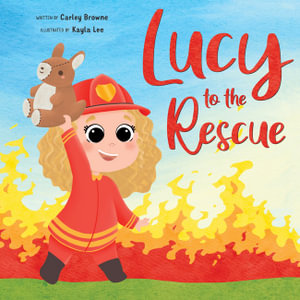Lucy to the rescue by Carley Browne. Illus. by Kayla Lee

Lucy to the rescue is a picture book about a little girl who tries to rescue her toy kangaroo from an imaginary fire by dressing as a firefighter and trying and failing with different methods before succeeding. The author, Carley Brown is an Australian children's author who enjoys writing bright and happy narratives for small children with the idea of sparking the imaginations of young readers. The illustrator, Kayla Lee, is an Adelaide based artist and designer who enjoys creating colourful illustrations for children. The three protagonists (Lucy and her parents) have disproportionately large heads and eyes, reminiscent of the Blythe dolls of the seventies and/or Japanese manga and anime characters.
Lucy to the rescue follows the rule of three for children's stories. Lucy tries three times to extinguish her imaginary fire before she succeeds on her fourth attempt. She tries by physical means: a hose, a spray bottle and then there is an odd attempt to ride a bike. It might have been more consistent for the reader if she had tried a third physical method for example using a fire blanket. After three failures, her father, an at-home Dad, comforts her and suggests that she creates her own fire engine. Lucy is re-energised. She creates her own cardboard fire engine and, with the help of a big pile of cushions, climbs up to rescue her toy. She runs into the arms of her firefighter mum who returns from work just in time for Lucy to tell her all about it.
The action occurs in the familiarity of Lucy's house. Lucy wakes from her safe slumber and is shocked to discover that Kanga is not there. This is the central problem. Lucy looks everywhere and finds her in a dangerous spot in need of rescue from the imaginary fire. The illustrations accompany the story well except for on page 4 where Lucy says, "Kanga! What are you doing up there?" and the illustration depicts Lucy looking underneath a pot plant stand.
This is a warm and engaging little story with an active little protagonist who is full of ideas, wants to help and has two loving parents in non-traditional career and family roles. The language is rich which is of VITAL importance for the vocabulary development of our young children. There is plenty of dialogue between Lucy and her Dad and a warm narrative voice. There are opportunites for this story to be read with LOTS of expression indicated by very large print and extra bolded words. The child could interact and have fun as the words Nee Nawww, nee Naww, etc. bounce out as part of the text design inviting interaction and the making of loud noises and exclamations etc. If read with the expression that this book invites and if children are encouraged to interact, there could be demands for this book to be read over and again. That is the test of a good picture book.
Themes: Firefighters, People who help, Solving problems.
Wendy Jeffrey